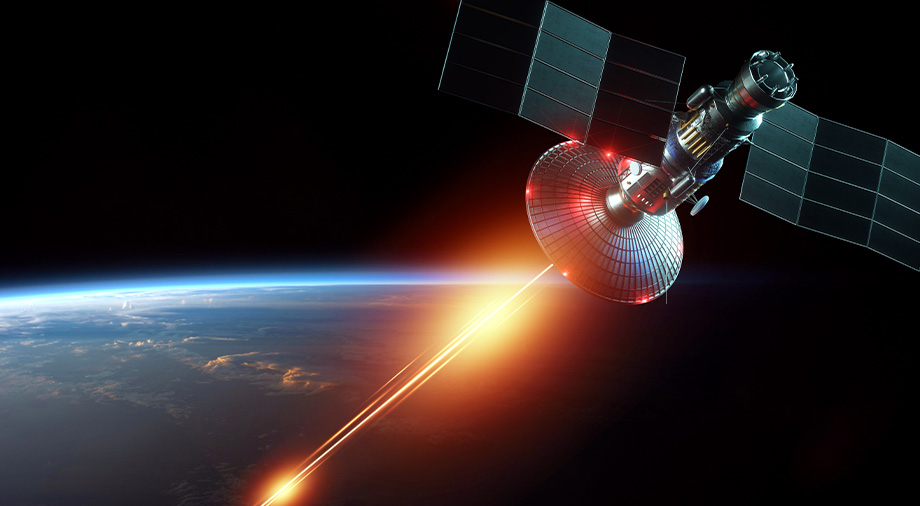Ambiguous changes in international politics, space-related security issues, the advance of technology, as well as the rapid development of the private aerospace sector has forced American lawmakers to reconsider the rules of the game in the NewSpace legal field. National interests have demanded greater freedom of action, and in an effort to provide it, on October 13, 2020, NASA initiated the creation of the Artemis Accords – a set of principles of international cooperation and conduct by states (as well as the companies within them) on the Moon, Mars, and other celestial bodies, as part of the implementation of the Artemis lunar program.

Today, the provisions of Artemis Accords aim to shape the global face of the NewSpace industry for decades, in the US as well as in other countries of the free world. But how fair are the Artemis Accords towards their participants, and do their provisions pave the road for the creation of the first monopolies for colonization and extraction of extraterrestrial resources?
We deal with all the intricacies of the Artemis Accords in part 4 of our What is allowed in space? series.
OST 2.0?
From the very beginning of the Artemis Accords, they have been touted as the ideological successor to the Outer Space Treaty (OST) from 1967. In many respects, both treaties are quite similar: they contain provisions on the conduct of space activities for peaceful purposes, guided by the principles of transparency and collective mutual assistance in case of emergencies.
However, it was not possible to achieve full transparency in the implementation of space activities, and the OST document did not foresee this. Section 8 of the Artemis Accords requires states to provide the public with scientific data from their space missions, but the parties themselves had to agree among themselves on what exactly to share with the scientific community.
But there was also something that the Artemis Accords sought to rewrite from the OST. Section 5 of the Accords addresses the need for interoperability and creation of uniform standards for joint space activities. In a purely theoretical respect, this meant that the entire industrial potential of the 24 states which have signed the agreements as of May 2023 would be involved in the Artemis space missions.
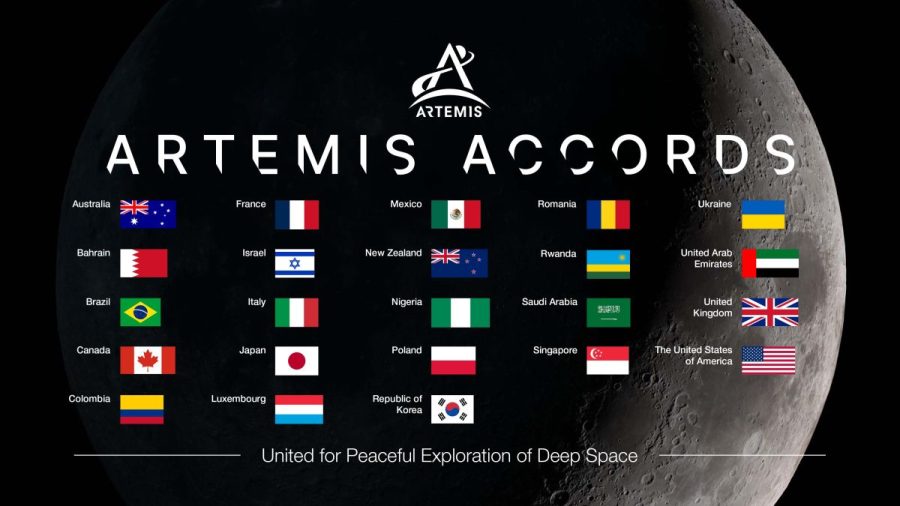
In addition to creating uniform production standards, Artemis Accords also offer a somewhat different interpretation of the provisions of the OST banning the nationalization and appropriation of any celestial bodies and their mineral contents. As a project initiated by the United States, the world’s largest economy, the Accords certainly pursue the goals of free commerce. Among other things, American aerospace companies are technically close to being able to conduct activities exploiting the mineral contents of celestial bodies.
Therefore, Section 10 of the Artemis Accords is devoted to the regulation of mining activities. It sets forth that the activities of states and private companies in the extraction of resources in space must be guided by the principles of safe and sustainable work and not interfere with other countries’ space exploration activities. When extracting resources, signatories also agree to provide the UN and open scientific communities with all data on the conduct of their activities, unless such information requires the divulging of trade secrets.
Anticipating the possibility of future territorial disputes over resource-rich celestial bodies, Section 11 of the Artemis Accords prescribed the need to create “safe zones:” specialized areas that states can temporarily “reserve” for their activities on the celestial body. Access to the safe zones is open to all parties to the treaty, subject to coordination of their actions with the party that formed the security zone.
Section 11, which appears aimed at preventing conflicts between signatories conducting space activities, nevertheless contains a rather controversial subparagraph – 7b. It allows for the expansion of the area of a “safety zone” if the nature of the space mission changes. In such a situation, we can imagine a situation in which, perhaps, a resource mining company that has discovered a highly rich deposit of extraterrestrial resources could prolong its stay in the area of interest for an arbitrarily long time, even expanding the boundaries of the zone if necessary.
This situation was accepted as fair by all signatories because they could, upon agreement, also have free access to safe zones and carry out joint extraction of resources. To date, however, only one company has sufficiently matured technologically to deliver equipment for such activities to the Moon and beyond. Its technical potential, legitimized by the provisions of the Artemis Accords, risks leaving other players in the cosmic dust.
Moreover, the Accords clearly state that not all rules apply to private aerospace companies. One example is found in Section 8, paragraph 3, which states that a private company must disclose information about its activities only if those activities are carried out on behalf of a signatory state. In all other cases, this data would fall under the trade secret coverage and can be hidden even to signatories of the Accords.
Artemis is changing the space launch industry
In order to better understand just how far ahead of the pack SpaceX is in the space launch market, just look at who in the US was delivering payloads into orbit in 2022. SpaceX launched just over 94% of the year’s reported 2,142 payloads. 118 cargoes were delivered to the Moon thanks to NASA and SpaceX launches.
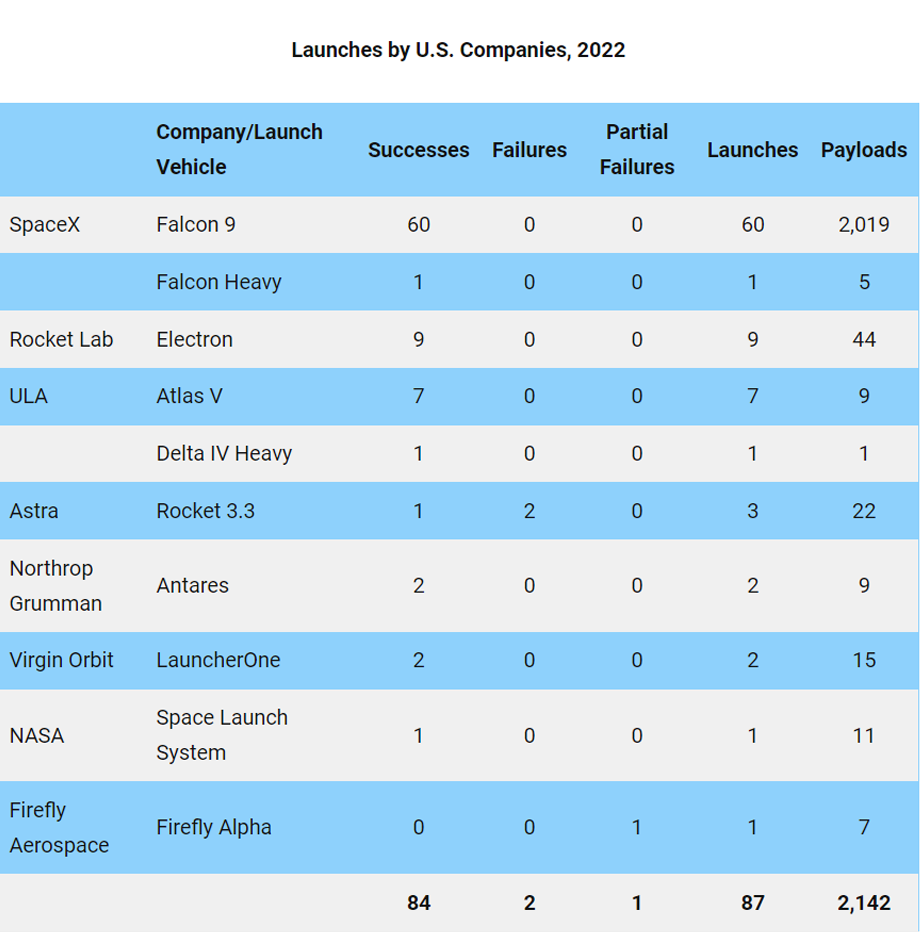
The lunar program was no exception to SpaceX’s dominance. In February 2022, NASA concluded a $1.15 billion contract with the company to use the Starship spacecraft to deliver astronauts to the Moon as part of the fourth Artemis mission, which is scheduled for 2027.
Earlier in April 2021, SpaceX had received a $2.9 billion contract from NASA to use a modified version of the Starship to take humans to the Moon as part of the Artemis III lunar mission. The spacecraft is planned to be launched into space using a Space Launch System (SLS) rocket. It is now clear that Starship will be used for future Artemis missions as well.
Recall that last year’s Artemis I and the future Artemis II will be launched on the SLS rocket, which was created on NASA’s instructions as a collaboration between Aerojet Rocketdyne, Northrop Grumman, Boeing, and United Launch Alliance.
The first two Artemis missions can rightfully be called demonstration ones, which are primarily aimed at exploring the capabilities of the Orion spacecraft, which is the second stage of the SLS rocket. But when it comes a little further, Orion’s functionality is clearly limited to a more sustainable presence on the Moon. And here for NASA today there is only one alternative – SpaceX. By entering into agreements like the launch of Artemis IV, NASA is effectively letting everyone know that it simply has no choice in delivering large payloads to the Moon.
Everything becomes clearer after comparing the two ships. Under ideal conditions (when all 33 Raptor engines are running), the Starship rocket can create 16.7 million pounds (≈75.7 million Newtons) of thrust, which is almost twice as high as NASA’s main SLS workhorse, whose four RS-25 provide just 8.8 million pounds of thrust (≈39.9 million Newtons).
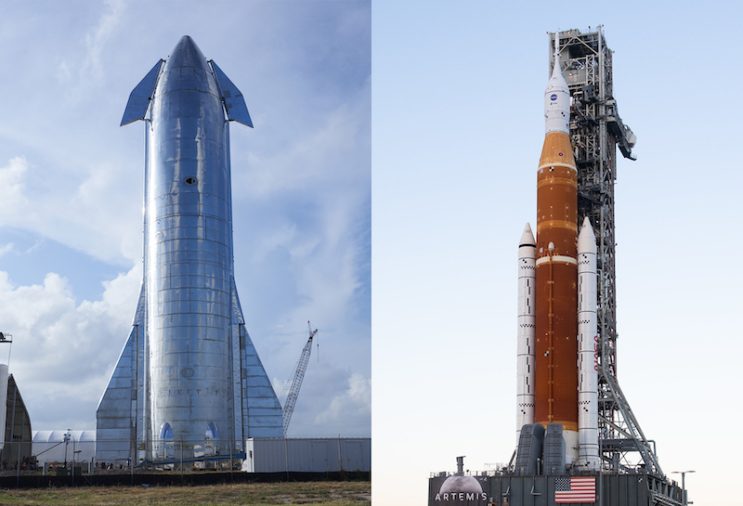
But it is not just the power of the rocket that is of interest to NASA in carrying out lunar missions. The lead Starship rocket (Starship/SuperHeavy second stage) has a capacity of 35,000 cubic feet (≈1 cubic ton). This capacity could include seating for 100 passengers. In comparison, the Orion spacecraft (the second stage of the SLS) has almost a hundred times less capacity at 316 cubic feet (≈9 cubic meters). And if you really want to colonize the Moon and Mars, SpaceX’s option is the only way to go.
But the problem today is that the full inclusion of private business in the process of colonization of the Moon, Mars, and the near asteroid belt first of all needs to be in demand on Earth, and for the widest possible segment of humanity. Otherwise, the extremely high cost would make the endeavor level of spending risks making this activity simply not economically workable. Today, many good startups that offer quite innovative approaches to the space industry find them completely inapplicable on the global market. Therefore, the only way to make money outside of Earth orbit (at least for today) is still government orders.
Private aerospace companies in this situation can count on more niche solutions. The American company Axiom Space has succeeded in developing spacesuits for the Artemis lunar missions.
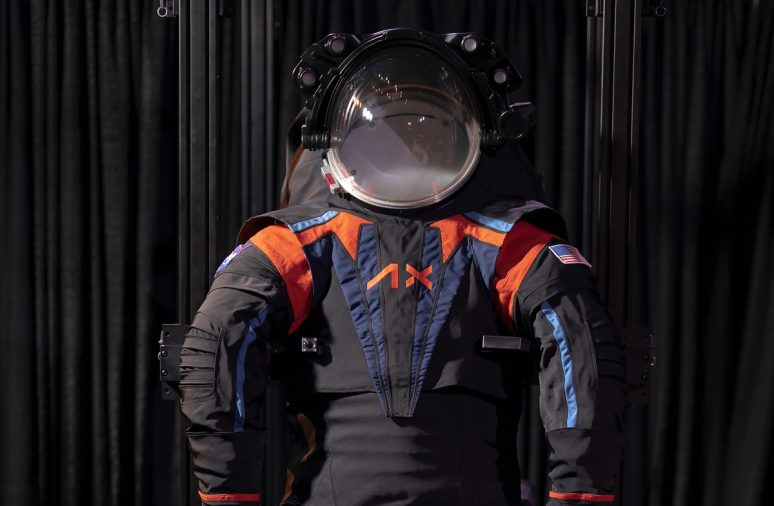
Despite the mishap in April that resulted in the loss of Hakuto-R, Japan’s ispace is also continuing to design small spacecraft landers in hopes of becoming first commercial company to take a probe to the Moon. The next Hakuto-R space mission will be for NASA’s CLPS (Commercial Lunar Payload Services) program, which is also part of Artemis. However, both the Axiom Space suits and the future Hakuto-Rs will predominantly fly on SpaceX rockets. As an exception, one can really only cite the participation of the aerospace company Firefly Aerospace, with which in March 2023 NASA signed a $112 million contract for payload delivery under CLPS. The company’s Blue Ghost spacecraft is expected to deliver 10 types of payload to the far side of the Moon in its debut.
It is worth saying that this success in the development of Starship (as well as other SpaceX projects) would not have been possible without funding through the many, many contracts that both NASA and the Pentagon feed SpaceX every year. Musk’s supporters will reasonably argue that SpaceX gets orders because it does its job better than others. Taking into account both facts, we can only state the obvious: of the 24 countries that have signed Artemis Accords, contracts for the delivery of people to the Moon so far only go to a 25th country: the country of Elon Musk.
Is SpaceX violating agreements?
The situation with the attitude of SpaceX itself to the principles set out in the Artemis Accords remains interesting. To put it mildly, it does not always follow them.
The fallout from the failed April launch of the Starship rocket has sharpened pressure from green conservationists. Recall that as a result of the failure of 5 out of 33 Raptor engines, the Starship / SuperHeavy rocket was unable to reach orbit, which resulted in it being remotely detonated.
A rather spectacular fire show from Elon Musk unfortunately had negative consequences for wildlife preserves in the Rio Grande valley. A week after launch, the US Fish and Wildlife Service estimated that small fragments from the destroyed rocket could have spread an area of 385 acres (1.5 million square meters).
American environmental groups quickly responded with the filing of a joining lawsuit, though not against SpaceX, but the Federal Aviation Agency – the government organization that issued SpaceX its flight license. Meanwhile, Musk continues to reassure the public with claims that SpaceX will be able to hold another Starship launch within 6-8 weeks.
Of course, the Starship/SuperHeavy detonation occurred in the Earth’s atmosphere and does not violate the provisions of the Artemis Accords, which apply to the Moon, Mars, and other celestial bodies. However, this is not the first episode in which the company has shown a rather dismissive attitude towards the provisions of the OST and Artemis Accords. Astronomers around the world have been trumpeting the dangers of the Starlink SpaceX satellite constellation for years, as its gradual growth is literally destroying observational astronomy, and not only amateur astronomy.

Source:National Optical-Infrared Astronomy Research Laboratory / CTIO / AURA / DELVE)
Recall that the Section 12 of the Artemis Accords just regulates the responsibility for the creation of orbital debris. The situation sets a rather absurd precedent in which the main workhorse of future missions, Artemis, quite openly ignores the prescriptions that are laid down in the mission agreements.
So where is the Moon?
In defense of the Accords, it is worth saying that they have created a major global market and technology exchange area. This, in turn, has led to the rapid growth of the space industry in a number of signatory countries.
In 2023, South Korea has budgeted a record 874.2 billion won ($674 million) for its space sector. The amount, which is an almost 20% increase over last year, will be directed to the creation of new launch vehicles, in particular the KSLV-2 gas liquid-oxygen rocket, which will be launched onMay 24 this year. On the other hand, South Korea has not even hinted that KSLV-2 (and the future KSLV-3) will be capable of making lunar missions.
In addition to expanding its space sector, South Korea has also expanded its cooperation with the initiator of the Artemis Accords, the United States. Without a doubt, most signatory countries are guided by the motive of their own security. And although the Artemis Accords themselves are in no way involved in testing military technologies, they de facto open the way for closer cooperation with the US Defense Department.
The Accords have also left behind the space sectors of China and Russia, which will no longer be able to take part in joint lunar missions with signatory countries. Differences in the interpretation of the main provisions of the Accords and their own ambitions in the field of exploration of the Moon have, as expected, led China and Russia to refuse to participate in the Artemis Accords. While China still continues to develop its plans to deliver people to the Moon (while no earlier than 2030), Russian space has already finally lost even illusory hopes of taking a place in the lunar club in the coming years. The last hope for Roskosmos is the Luna-25 unmanned lunar lander, which is set to be launched this July from the Vostochny cosmodrome. We can only hope that the Russians have provided the module with a trampoline for a softer landing, since should the Luna-25 fail, Russia will say goodbye to its last hope of mastering the Moon.
Be that as it may, the Artemis Accords have been and remain a voluntary initiative, and though the Russian and Chinese governments have chosen confrontation instead of cooperation, they have only themselves to blame.
In the meantime, the private sectors of Accords signatories are building new bridges that sometimes lead to productive cooperation. One such example is the German rocket company Rocket Factory Augsburg (RFA), which is currently designing the RFA-1 launch vehicle using a mixture of kerosene and liquid oxygen. The thrust of the RFA-1 rocket is provided by 9 Helix closed-cycle LREs (liquid propellant rocket engines) in the rocket’s first stage. Another Helix is being installed on the RFA-1 second stage.
Helix is not only made of German components. The Ukrainian enterprise Pivdenmash has developed turbopumps that run these rather productive engines, which as a set of nine provide 90-100 tons of thrust.
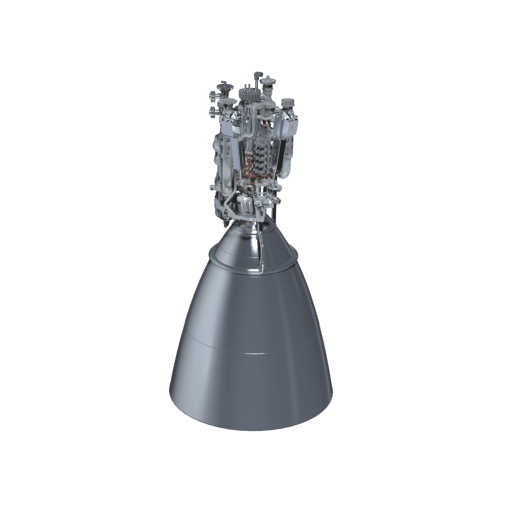
Source: RFA
Both Ukraine and Germany are members of Artemis Accords, and perhaps it was the working contacts within the framework of their participation in the lunar program that helped to establish this cooperation. This again remains a matter of conjecture, but the reality is that the RFA-1 rocket also does not plan to deliver a payload to the Moon.
As a result, potentially talented rocket-building companies (especially young ones) have to come to terms with the reality that they will have to work in Earth orbit to make money. NASA decided to entrust the conquest of the Moon to their main and only favorite, SpaceX. Perhaps it was for this purpose that Elon Musk’s company was fed such mouth-watering chunks of the American space budget year after year. This theory, although entertaining, is no longer relevant today.
This situation can in no way be encouraging for other aerospace companies (not just American ones) that are now working on space launches. Future debuts of Blue Origin’s New Glenn, ArianeGroup’s Ariane 6, or ULA’s Vulcan Centaur super-heavy rockets, set to take place in the coming years, could try to make a difference in lunar exploration vehicles. But even success in these missions does not guarantee them a place in the Artemis program, NASA will confirm – this goddess does only love her chosen ones.





